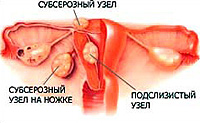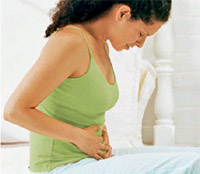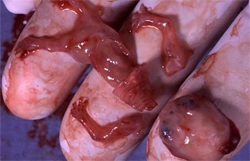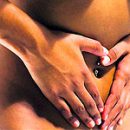Ovarian cyst - pathological education in ovarian tissue, consisting of a cavity limited capsule and filled liquid. Depending on the content, the cysts are divided into: follicular, yellow-body cysts, merindic, endometroid, dermoid.
Content
Causes of the development of the cyst of the ovary
The reasons for the development of the cyst of the ovary - the great set, but there are no symptoms of the disease as such, so with all its prevalence, it is impossible to identify it on its own. For this reason, the cyst of ovarian Usually it is found randomly during ultrasound examination. Thus, it is very important to regularly visit the gynecologist for preventive inspection.
Under the guidance of the hypothalamic-pituitary system, a healthy ovary produces hormones that regulate the ripening of the follicle and the formation of a yellow body. Until 14-16 days of the menstrual cycle, the follicle grows, producing estrogen, after which it takes place and the exit of the egg (ovulation). If the rupture of the follicle does not occur, a follicular cyst is formed in its place. At the site of the burst follicle, a yellow body is formed, which produces progesterone. If the yellow body does not undergo reverse development, the cyst of the yellow bodies of the ovary is formed. It can reach sizes up to 10-12 cm.
 Music cysts are filled with mucous content, often consist of several cameras and can achieve large sizes.
Music cysts are filled with mucous content, often consist of several cameras and can achieve large sizes.
- Endometrioid cysts are characterized by the presence of endometri-like foci.
- Music and endometrium cysts are able to reborn into malignant ovarian tumors.
- Dermoid cysts contain part of embryonic germinal sheets.
The reason for the occurrence of the ovarian cyst is usually a violation of follicleogenesis, hormonal instability, early start of menstruation, hypoteriosis, endocrine disorders, abortions in the past, hormonal disorders.
The ovarian cyst is a widespread condition, diagnosed in 30% of women with regular and in 50% with an irregular menstrual cycle. After the occurrence of menopause, the frequency of the cyst is reduced to 6%.
Diagnosis of the cyst of the ovary
As a rule, uncomplicated cysts proceed asymptomatic and are a random find in ultrasound examination.
In case of endometropic cysts, the leading symptom is a constant, novice pain in the abdomen, increasing the day before and during menstruation. This type of cysts are very often accompanied by adhesive processes in a small pelvis, which leads to a violation of the intestinal and bladder work (constipation, rapid urination).
Endometrous cysts often accompanied by infertility.
With any type of cyst, a slight increase in body temperature can be observed, a lamination of the menstrual cycle (more scarce or abundant menstruation, shortening or lengthening of the menstrual cycle). With large sizes of cyst, an asymmetrical increase in abdomen.
Cyst may be complicated by a gap, fitting, twisted legs of cysts. At the same time, the following symptoms arise:
- Intense, sudden pain at the bottom of the abdomen
- Increase body temperature up to 38-39c
- nausea or vomiting, not bringing relief
- Student heartbeat (tachycardia)
- The voltage of the front abdominal wall
For diagnosis The ovarian cysts apply the following methods:
- Gynecological examination
- Ultrasound – The most common and informative method, especially when using a transvaginal and transabdominal sensor
- Vagina rear axle – Allows you to determine the presence of blood or liquid in the abdominal cavity, most often used with complicated cysts
- Laparoscopy – It is used if the cyst break is suspected or twisted the legs of the cyst, it allows you to carry out a surgical intervention in addition to diagnostics
- Determination of tumor markers-antigens (antigen-125)
- CT scan – allows you to distinguish the cyst from the neoplasms of the ovaries
- General analysis of blood and urine to identify blood loss, inflammation
- Pregnancy test, to eliminate ectopic pregnancy.
Treatment of ovarian cysts
With uncomplicated cysts, monophasic and 2-phase oral contraceptives are used. Vitamins A, E, B1, B6, K, ascorbic acid are prescribed. In some cases, the use of needleflexotherapy, homeopathic preparations.
For patients with high body weight, nutrition, healing physical culture and balneotherapy are recommended. Fatty fabric is depot of androgens, broken hormone metabolism.
Treatment dynamics are controlled by an ultrasound, in the ineffectiveness of conservative treatment applied surgical.
With dermoid, endometrium, mudiginous cysts, only surgical treatment is used.
With complicated ovarian cysts, urgent surgical assistance should be provided, in case of sudden acute pain in the abdomen, it is necessary to call an ambulance brigade.
In children's, adolescent and childbearing age, resection of the ovary, with the preservation of the unchanged section. In the premenopausal period, the uterus is deleted (hysterectomy) with appendages or removal of ovarian (ovarielectomy). Operations can be carried out both in the usual way and endoscopically. After surgical intervention, restoration treatment is carried out.









